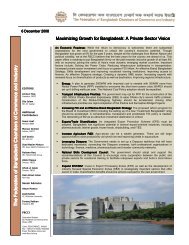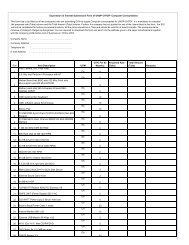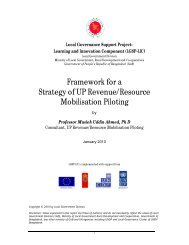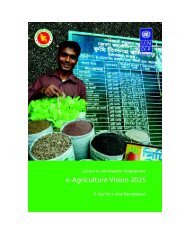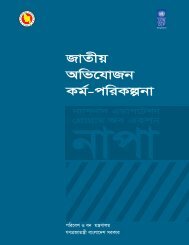The probable impacts of climate change on poverty - UNDP
The probable impacts of climate change on poverty - UNDP
The probable impacts of climate change on poverty - UNDP
You also want an ePaper? Increase the reach of your titles
YUMPU automatically turns print PDFs into web optimized ePapers that Google loves.
Figure 3.2 Linkage and Formulati<strong>on</strong> <str<strong>on</strong>g>of</str<strong>on</strong>g> Strategies for Adaptati<strong>on</strong> and Mitigati<strong>on</strong><br />
Source: IPCC<br />
Human interference<br />
MITIGATION<br />
<str<strong>on</strong>g>of</str<strong>on</strong>g> <str<strong>on</strong>g>climate</str<strong>on</strong>g> <str<strong>on</strong>g>change</str<strong>on</strong>g> via<br />
GHG sources and sinks<br />
3.3 Analytical Methods and Tools<br />
Different analytical tools and methods are used for assessing the <str<strong>on</strong>g>probable</str<strong>on</strong>g> <str<strong>on</strong>g>impacts</str<strong>on</strong>g> <str<strong>on</strong>g>of</str<strong>on</strong>g> <str<strong>on</strong>g>climate</str<strong>on</strong>g> <str<strong>on</strong>g>change</str<strong>on</strong>g> <strong>on</strong> <strong>poverty</strong><br />
and ec<strong>on</strong>omic growth. Both qualitative and quantitative methods, statistical tools, and Geographic Informati<strong>on</strong><br />
System (GIS) have been used to analyse <strong>poverty</strong> and <str<strong>on</strong>g>climate</str<strong>on</strong>g> <str<strong>on</strong>g>change</str<strong>on</strong>g> related data and informati<strong>on</strong>. <str<strong>on</strong>g>The</str<strong>on</strong>g> following<br />
secti<strong>on</strong> provides a summary <str<strong>on</strong>g>of</str<strong>on</strong>g> different approaches and methods employed in this study.<br />
3.3.1 Assessment <str<strong>on</strong>g>of</str<strong>on</strong>g> Probable Impacts <str<strong>on</strong>g>of</str<strong>on</strong>g> Climate Change <strong>on</strong> Poverty and Ec<strong>on</strong>omic Growth<br />
3.3.1.1 Analysis <str<strong>on</strong>g>of</str<strong>on</strong>g> Poverty Database<br />
Analysis <str<strong>on</strong>g>of</str<strong>on</strong>g> <strong>poverty</strong> data includes compilati<strong>on</strong> <str<strong>on</strong>g>of</str<strong>on</strong>g> <strong>poverty</strong> database by regi<strong>on</strong> and dependency <str<strong>on</strong>g>of</str<strong>on</strong>g> household <strong>on</strong><br />
different sectors as primary source <str<strong>on</strong>g>of</str<strong>on</strong>g> income. <str<strong>on</strong>g>The</str<strong>on</strong>g> primary source <str<strong>on</strong>g>of</str<strong>on</strong>g> income has been used as indicator <str<strong>on</strong>g>of</str<strong>on</strong>g> main<br />
livelihood. Data and informati<strong>on</strong> have been collected from sec<strong>on</strong>dary sources which include Bangladesh Bureau<br />
<str<strong>on</strong>g>of</str<strong>on</strong>g> Statistics (BBS) for <strong>poverty</strong> and ec<strong>on</strong>omic growth. Other sources are FAO, <strong>UNDP</strong> General Ec<strong>on</strong>omic Divisi<strong>on</strong> etc.<br />
<str<strong>on</strong>g>The</str<strong>on</strong>g> team members visited these organizati<strong>on</strong>s for collecting data and informati<strong>on</strong> <strong>on</strong> <strong>poverty</strong> and ec<strong>on</strong>omic<br />
growth. <str<strong>on</strong>g>The</str<strong>on</strong>g> General Ec<strong>on</strong>omic Divisi<strong>on</strong> <str<strong>on</strong>g>of</str<strong>on</strong>g> the Planning Commissi<strong>on</strong> has been visited for collecti<strong>on</strong> <str<strong>on</strong>g>of</str<strong>on</strong>g> data <strong>on</strong><br />
ec<strong>on</strong>omic growth, PRSP and <strong>poverty</strong> related data and informati<strong>on</strong>. <str<strong>on</strong>g>The</str<strong>on</strong>g> collected data has been analyzed to<br />
understand the trend <str<strong>on</strong>g>of</str<strong>on</strong>g> <strong>poverty</strong> and ec<strong>on</strong>omic growth and linked with trend <str<strong>on</strong>g>of</str<strong>on</strong>g> <str<strong>on</strong>g>climate</str<strong>on</strong>g> <str<strong>on</strong>g>change</str<strong>on</strong>g> for future<br />
planning. Geographic Informati<strong>on</strong> System (GIS) has been used to analyze data in the special c<strong>on</strong>text and<br />
presentati<strong>on</strong> <str<strong>on</strong>g>of</str<strong>on</strong>g> analytical informati<strong>on</strong> through maps.<br />
3.3.1.2 Assessment <str<strong>on</strong>g>of</str<strong>on</strong>g> Impacts <strong>on</strong> Key Sectors and by Regi<strong>on</strong>s<br />
While assessing <str<strong>on</strong>g>climate</str<strong>on</strong>g> <str<strong>on</strong>g>impacts</str<strong>on</strong>g> <strong>on</strong> different sectors and society it is necessary to keep in mind that it will not<br />
affect all the sectors and regi<strong>on</strong>s equally as menti<strong>on</strong>ed in the c<strong>on</strong>ceptual framework. <str<strong>on</strong>g>The</str<strong>on</strong>g>refore, the <str<strong>on</strong>g>impacts</str<strong>on</strong>g> <str<strong>on</strong>g>of</str<strong>on</strong>g><br />
<str<strong>on</strong>g>climate</str<strong>on</strong>g> <str<strong>on</strong>g>change</str<strong>on</strong>g> <strong>on</strong> different sectors and by regi<strong>on</strong>s have been assessed using GIS and statistical package. <str<strong>on</strong>g>The</str<strong>on</strong>g><br />
IPCC reports, <strong>UNDP</strong> country study reports, Nati<strong>on</strong>al Adaptati<strong>on</strong> Programme <str<strong>on</strong>g>of</str<strong>on</strong>g> Acti<strong>on</strong> (NAPA) and other relevant<br />
study reports have been reviewed and assessed during this assessment as well. One <str<strong>on</strong>g>of</str<strong>on</strong>g> the critical issues is<br />
harm<strong>on</strong>izati<strong>on</strong> <str<strong>on</strong>g>of</str<strong>on</strong>g> time dimensi<strong>on</strong> <str<strong>on</strong>g>of</str<strong>on</strong>g> <str<strong>on</strong>g>climate</str<strong>on</strong>g> <str<strong>on</strong>g>change</str<strong>on</strong>g> <str<strong>on</strong>g>impacts</str<strong>on</strong>g> and target <str<strong>on</strong>g>of</str<strong>on</strong>g> <strong>poverty</strong> reducti<strong>on</strong> and Millennium<br />
Development Goals. This has been d<strong>on</strong>e by simple down scaling thought dividing level <str<strong>on</strong>g>of</str<strong>on</strong>g> <str<strong>on</strong>g>impacts</str<strong>on</strong>g> <str<strong>on</strong>g>of</str<strong>on</strong>g> <str<strong>on</strong>g>climate</str<strong>on</strong>g><br />
<str<strong>on</strong>g>change</str<strong>on</strong>g> by time to match with <strong>poverty</strong> target and Millennium Development Goals.<br />
<str<strong>on</strong>g>The</str<strong>on</strong>g> Probable Impacts <str<strong>on</strong>g>of</str<strong>on</strong>g> Climate Change <strong>on</strong> Poverty and Ec<strong>on</strong>omic Growth and<br />
the Opti<strong>on</strong>s <str<strong>on</strong>g>of</str<strong>on</strong>g> Coping with adverse Effect <str<strong>on</strong>g>of</str<strong>on</strong>g> Climate Change in Bangladesh<br />
I M P A C T S<br />
CLIMATE CHANGE<br />
including variability<br />
Exposure,<br />
Sensitivity<br />
Initial Impacts<br />
or Effects<br />
Aut<strong>on</strong>omous<br />
Adjustments<br />
Residual or<br />
Net Impacts<br />
Policy resp<strong>on</strong>ses<br />
V U L N E R A B I L I T I E S<br />
Planned<br />
ADAPTATION<br />
to the <str<strong>on</strong>g>impacts</str<strong>on</strong>g> and<br />
vulnerabilities<br />
15




